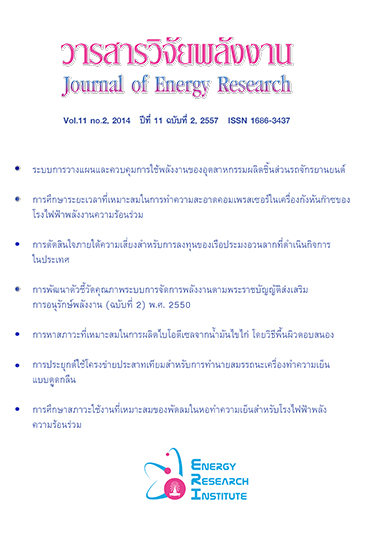การพัฒนาตัวชี้วัดคุณภาพระบบการจัดการพลังงานตามพระราชบัญญัติส่งเสริมการอนุรักษ์พลังงาน (ฉบับที่ 2) พ.ศ. 2550
Main Article Content
Abstract
วัตถุประสงค์ที่สำคัญของการการวิจัยเรื่องนี้คือ 1) เพื่อพัฒนาตัวชี้วัดคุณภาพการจัดการพลังงานตามกฎกระทรวงกำหนดมาตรฐาน หลักเกณฑ์และวิธีการจัดการพลังงานในอาคารควบคุม 2) เพื่อประเมินประสิทธิภาพตัวชี้วัดคุณภาพการจัดการพลังงานที่พัฒนาขึ้น และ 3) เพื่อศึกษาเปรียบเทียบสภาพการจัดการพลังงานของอาคารควบคุมที่มีลักษณะอาคารแตกต่างกัน ดำเนินการวิจัยทั้งเชิงปริมาณ และเชิงคุณภาพ โดยเก็บข้อมูลสภาพการจัดการพลังงาน และความเหมาะสมของตัวชี้วัดคุณภาพจากอาคารควบคุมจำนวน 324 อาคารโดยวิธีการสุ่มอย่างง่าย นำข้อมูลที่ได้มาวิเคราะห์หาความเหมาะสมของตัวชี้วัดคุณภาพการจัดการพลังงาน และสร้างคู่มือการประเมินคุณภาพการจัดการพลังงาน จากนั้นทำการทดลองประเมินคุณภาพการจัดการพลังงานจากตัวชี้วัดที่พัฒนาขึ้นกับอาคารจำนวน 10 อาคาร ซึ่งเลือกแบบเจาะจง นำผลที่ได้มาสัมมนากลุ่มย่อย แล้วประเมินผลตัวชี้วัดโดยผู้ทรงคุณวุฒิด้านพลังงานและผู้เกี่ยวข้อง การวิเคราะห์ข้อมูลวิเคราะห์ด้วยสถิติเชิงพรรณนาได้แก่ ค่าความถี่ ค่าร้อยละ ค่าเฉลี่ย ส่วนเบี่ยงเบนมาตรฐาน และเปรียบเทียบความแตกต่างของการจัดการพลังงานด้วยการทดสอบสมมุติฐานค่าสถิติ t – test และ One way ANOVA
ผลการวิจัยพบว่า ตัวชี้วัดคุณภาพการจัดการพลังงานที่พัฒนาขึ้นมี 8 องค์ประกอบมีตัวชี้วัดคุณภาพรวมจำนวนทั้งสิ้น 22 ตัวชี้วัด จำแนกเป็น ขั้นตอนที่ 1 คณะทำงานด้านการจัดการพลังงาน 5 ตัวชี้วัด ขั้นตอนที่ 2 การประเมินสถานภาพการจัดการพลังงานเบื้องต้น 2 ตัวชี้วัด ขั้นตอนที่ 3 นโยบายอนุรักษ์พลังงาน 2 ตัวชี้วัด ขั้นตอนที่ 4 การประเมินศักยภาพการอนุรักษ์พลังงาน 2 ตัวชี้วัด ขั้นตอนที่ 5 การกำหนดเป้าหมายและแผนอนุรักษ์พลังงาน 5 ตัวชี้วัด ขั้นตอนที่ 6 การดำเนินการตามแผนอนุรักษ์พลังงานฯ 3 ตัวชี้วัด ขั้นตอนที่ 7 การตรวจติดตามและประเมินการจัดการพลังงาน 1 ตัวชี้วัด และขั้นตอนที่ 8 การทบทวน ฯ การจัดการพลังงาน 2 ตัวชี้วัด จำแนกเป็นตัวชี้วัดนำเข้า Input) จำนวน 4 ตัวชี้วัด ตัวชี้วัดกระบวนการ (Process) จำนวน 13 ตัวชี้วัด ตัวชี้วัดผลผลิต (Output) จำนวน 5 ตัวชี้วัด
เพื่อประเมินประสิทธิภาพตัวชี้วัดคุณภาพการจัดการพลังงาน ผลการวิจัยพบว่าผลการทดลองตรวจประเมินตามตัวชี้วัดคุณภาพที่พัฒนาขึ้นของอาคารควบคุม 10 อาคารมีคุณภาพระบบการจัดการพลังงานระดับดี (= 3.81 คะแนน S.D. = 0.49 คะแนน) ผลการวิเคราะห์ค่าความเชื่อมั่นของการประเมินพบว่า มีค่าสัมประสิทธิ์ความเชื่อมั่นแบบครอนบาคแอลฟ่า คือ 0.9116 และผู้ทรงคุณวุฒิมีความคิดเห็นว่าประสิทธิภาพตัวชี้วัดคุณภาพการจัดการพลังงานอาคารควบคุมมีความเหมาะสมระดับมาก (= 4.41 คะแนน S.D. = 0.12 คะแนน) รวมทั้งให้ความเห็นว่า คู่มือและกระบวนการประเมินคุณภาพการจัดการพลังงานมีความเหมาะสมระดับมาก (= 4.38 คะแนน S.D. = 0.10 คะแนน)
เพื่อศึกษาเปรียบเทียบสภาพการจัดการพลังงานผลการวิจัยพบว่า โดยเฉลี่ยสภาพของการจัดการพลังงานของอาคารควบคุมที่มีลักษณะอาคารแตกต่างกัน กลุ่มอาคารแตกต่างกัน ประเภทอาคารแตกต่างกัน มีจำนวนพนักงานแตกต่างกัน และมีที่ตั้งอาคารแตกต่างกัน ต่างมีการจัดการพลังงานแตกต่างกันอย่างไม่มีนัยสำคัญทางสถิติ
A DEVELOPMENT OF QUALITY INDICATORS FOR ENERGY MANAGEMENT SYSTEM IN ENERGY CONSERVATION PROMOTION ACT (NO.2), B.E. 2550 (2007)
Anek Thianboocha
Program of Technology Management, Faculty of Science, Chandrakasem Rajabhat University
The objectives of this study were to develop the indicators indicating the quality of energy management, to evaluate the effectiveness of such indicators and to compare the management conditions of energy in different controlled buildings. The study was undertaken by both qualitative and quantitative research approaches. The data were collected from different types of buildings, different conditions of energy management and many appropriate quality indicators from 324 buildings. They were then analyzed to find the indicators for quality energy management and to use for writing a manual for evaluating the mentioned management. Then, based on the found indicators, 10 buildings were evaluated by using the new written manual as a pilot project. The findings from the study were used in a small-group seminar. Comments and suggestions from experts in the fields and persons concerned were analyzed and summarized as the findings of this study as follows:
Firstly, it was found that there were 8 factors in key performance indicators for quality energy management system according to the steps set by the Energy Conservation Promotion Act (No.2) , B.E. 2550 (2007). There were 22 key indicators altogether. Step 1, there were 5 indicators in Energy Management Committee. Step 2, there were 2 indicators in Basic Energy Management Condition Evaluation. Step 3, there were 2 indicators in Energy Conservation Policies. Step 4, there were 2 indicators in Energy Conservation Potential Evaluation. Step 5, there were 5 indicators in Target Determination and Energy Conservation Plans. Step 6, there were 3 indicators in Energy Conservation Plan Implementation. Step 7, there was 1 indicator in Energy Management Follow-up and Evaluation. Step 8, there were 2 indicators in Energy Management Revision which composed of 4 indicators for Input, 13 indicators for Process and 5 indicators for Output.
Secondly, to evaluate the effectiveness of such indicators, it revealed that the developed indicators could be used to evaluate the 10 buildings at “Good Level” (mean = 3.81, S.D. = 0.49). The Cronbach’s Alpha reliability coefficient was 0.9116. Based on the experts’ opinions on the effectiveness of the indicators, on average, it was found that it was “Very Appropriate” (mean = 4.41, S.D. = 0.12). Besides, it revealed that the evaluation manual and the evaluation process was also “Very Appropriate” (mean = 4.38, S.D. = 0.10).
Finally, it was found that, in general, the energy management conditions in controlled buildings with different typical characteristics, groups, types, number of office workers and even locations were not significantly different (p = 0.05).

